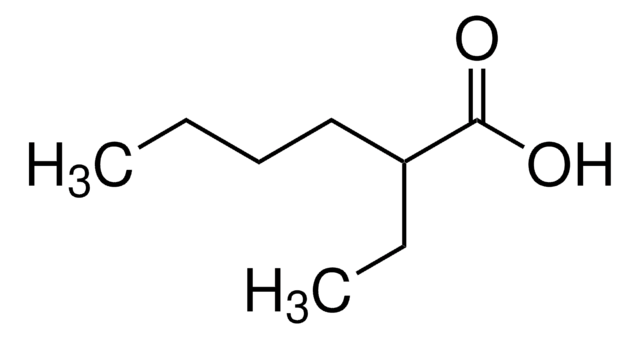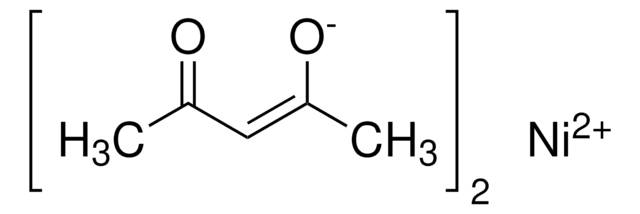940631
Nickel(II) acetate

(anhydrous), ≥99.9% trace metals basis (basis)
Synonyme(s) :
Nickel acetate, Nickel(2+) acetate, Nickelous acetate
About This Item
Produits recommandés
Niveau de qualité
Essai
(EDTA titration)
≥99.9% trace metals basis (basis)
Forme
powder, crystals or chunks
Solubilité
water: soluble
Traces d'anions
chloride (Cl-): ≤50 ppm
sulfate (SO42-): ≤50 ppm
Traces de cations
Al: ≤10 ppm
Ca: ≤10 ppm
Cd: ≤10 ppm
Cr: ≤10 ppm
Cu: ≤10 ppm
Fe: ≤10 ppm
K: ≤10 ppm
Mg: ≤10 ppm
Na: ≤30 ppm
Pb: ≤10 ppm
Si: ≤10 ppm
Zn: ≤10 ppm
Chaîne SMILES
CC(=O)[O-].CC(=O)[O-].[Ni+2]
InChI
InChI=1S/C2H4O2.Ni/c1-2(3)4;/h1H3,(H,3,4);
Clé InChI
XMOKRCSXICGIDD-UHFFFAOYSA-N
Description générale
Application
For example: Nickel(II) acetate, anhydrous, is employed in the synthesis of spinel Lithium Nickel Manganese Oxide (LNMO) using a precipitation method, in the presence of Manganese(II) Acetate and Manganese Oxalate in a microemulsion system. The resulting porous nanorods of spinel-type LiNi0.5Mn1.5O4, composed of assembled nanoparticles, have been investigated as cathode materials for rechargeable lithium-ion batteries, demonstrating excellent performance in high-rate capability and long cycle life. In one of the studies, it shows that Nickel(II) Acetate, anhydrous, in conjunction with tetrabutyl titanate, has been utilized as a precursor in the presence of ethylene glycol to synthesize porous NiTiO3 nanorods using an ethylene glycol-mediated route, followed by calcination at 600 °C at room temperature. These porous nanorods have demonstrated excellent performance in the visible light photocatalytic degradation of nitrobenzene, making them a promising material for visible light photocatalysis applications. Furthermore, Nickel(II) Acetate, anhydrous, has been studied for its application as a precursor in the synthesis of N-doped sponge nickel, comprising interconnected Ni micro/nanofibers, prepared through a hydrothermal method using nickel acetate followed by annealing in NH3. This unique catalyst exhibits a 3D porous structure and high electronic conductivity, making it suitable for the oxygen evolution reaction (OER) in applications such as water splitting and rechargeable metal-air batteries.. Nickel(II) acetate anhydrous Interestingly, Nickel(II) Acetate, anhydrous, has found application in polymer solar cells utilizing poly(3-hexylthiophene) (P3HT) and indene-C60 bisadduct (ICBA), where it is employed as the hole collection layer. After thermal annealing, nickel acetate demonstrates high transparency, suitable energy levels, and a high hole mobility, establishing its potential as an alternative to conventional PEDOT:PSS for the hole collection layer in these solar cells.
Caractéristiques et avantages
2.Suitable for battery and solar cell applications due to low moisture content
3.Low anion content (chloride & sulfate)
4.High purity of 99.9% (<1000 ppm)
5. Similar Specification like battery grade
Mention d'avertissement
Danger
Mentions de danger
Conseils de prudence
Classification des risques
Acute Tox. 4 Inhalation - Acute Tox. 4 Oral - Aquatic Acute 1 - Aquatic Chronic 1 - Carc. 1B Inhalation - Muta. 2 - Repr. 1B - Resp. Sens. 1 - Skin Sens. 1 - STOT RE 1
Code de la classe de stockage
6.1C - Combustible acute toxic Cat.3 / toxic compounds or compounds which causing chronic effects
Classe de danger pour l'eau (WGK)
WGK 3
Point d'éclair (°F)
Not applicable
Point d'éclair (°C)
Not applicable
Faites votre choix parmi les versions les plus récentes :
Certificats d'analyse (COA)
It looks like we've run into a problem, but you can still download Certificates of Analysis from our Documents section.
Si vous avez besoin d'assistance, veuillez contacter Service Clients
Déjà en possession de ce produit ?
Retrouvez la documentation relative aux produits que vous avez récemment achetés dans la Bibliothèque de documents.
Les clients ont également consulté
Notre équipe de scientifiques dispose d'une expérience dans tous les secteurs de la recherche, notamment en sciences de la vie, science des matériaux, synthèse chimique, chromatographie, analyse et dans de nombreux autres domaines..
Contacter notre Service technique
![[Pd(OAc)2]3 reagent grade, 98%](/deepweb/assets/sigmaaldrich/product/structures/508/249/99a0ef2c-b77c-4d73-8ed9-0cca05b6b41f/640/99a0ef2c-b77c-4d73-8ed9-0cca05b6b41f.png)












